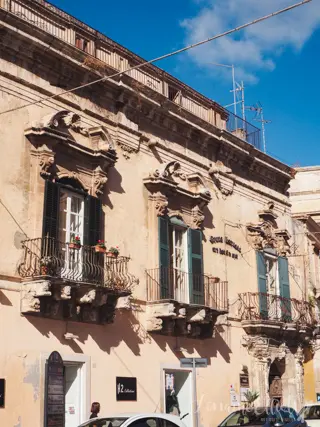
Modica is one of the most beautiful towns in all of Sicily. Nestled inside a valley made up of four hills, a 1693 earthquake transformed this medieval town into a town lined with baroque facades. There's also a sweet side to Modica with a very famous product made here: Modica chocolate that is unlike any other chocolate you have ever tried. Afterwards we also visit a cheese factory whose owner has taken on the supermarket giants and won with his incredible fresh, hot ricotta.
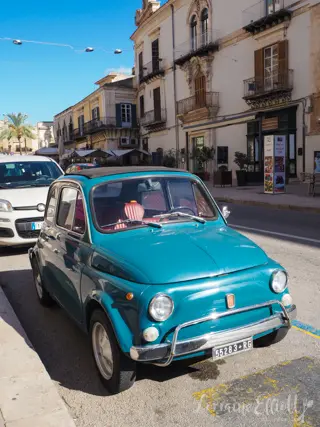
We are busy marvelling at the beauty of the buildings in Modica before Carm our guide at Sicilian Food Tours ushers into the Antica Dolceria Bonajuto. "You can take photos later," she says moving us into the chocolate factory.

Modica chocolate is unique. It is cold pressed and retains much of the nutrition of cacao beans but this cold press or grinding also means that the chocolate is slightly gritty in texture. Think the opposite of a super smooth milk chocolate.
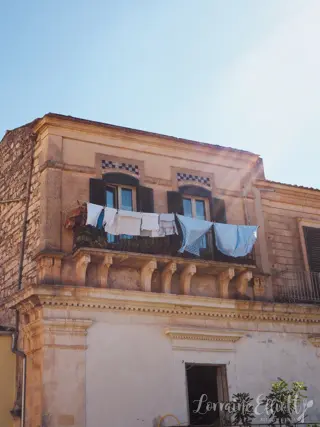
Our guide at Antica Dolceria Bonajuto hands around samples of their summer iced chocolate. This version is made with cocoa, water, sugar and carob seed flour to thicken it. It's deliciously rich and quite creamy despite containing no dairy and being vegan.
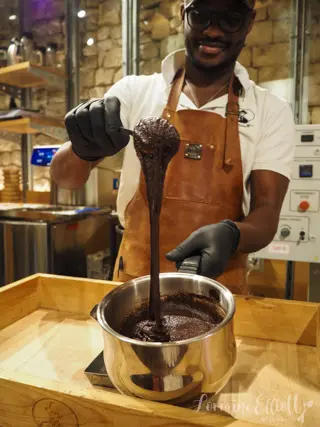
Antica Antica Dolceria Bonajuto opened in 2018 and sells bean to bar chocolate. They have 8 types of cocoa beans from Mexico, Columbia, Peru and Venezuela. They explain that only 3% of an entire cacao plantation produces cocoa pods in shades of green, yellow and red depending on type of tree. In each pod are around 20-40 cocoa beans.
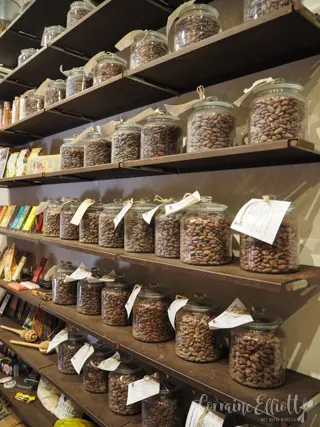
After splitting the cacao pod open they use a guillotine tool to grade the cocoa beans. Despite the name of the tool there is no beheading or cutting the beans. After sorting they are cleaned, roasted and winnowed resulting in a cocoa mass. It is then milled for 22-24 hours and then placed in a tempering machine at 28-45C/82-113F. Afterwards it is placed in the metal and polycarbonate molds that are then shaken and then placed in a special chocolate fridge for 12 hours to set.
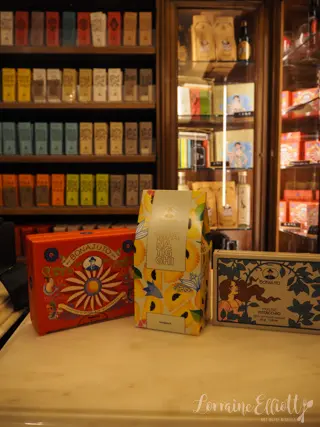
Afterwards they give us a gift box with a range of samples of their chocolates including orange, 70%, pepperoncino, vanilla as well as samples of their nougat as well as one very special Modica snack: a 'Mpanatigghie di Modica. This half moon shaped paastry is filled with beef and chocolate. According to legend, it was the nuns of a Modica convent in the 16th century who came up with the idea of making biscuits filled with meat to give priests enough energy during Lent while continuing their prayers. It is also quite likely it was inspired by the Spanish who occupied Sicily for 500 years as it resembles an empanada. 'Mpanatigghie was also called a travelling biscuit with the cocoa acting as a preservative. These biscuits have a shelf life of around a month and can be kept at room temperature. We also try samples of their chocolate liquor.
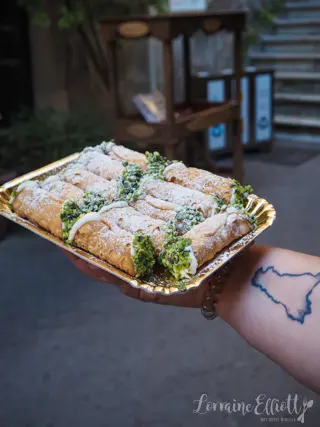
Afterwards we head next door to their chocolate shop where they offer us samples of their chocolate. The grittiness of their chocolate is very fine like small crystals of sugar that have not melted and the boxes make for beautiful gifts too. We finish our visit with cannoli.
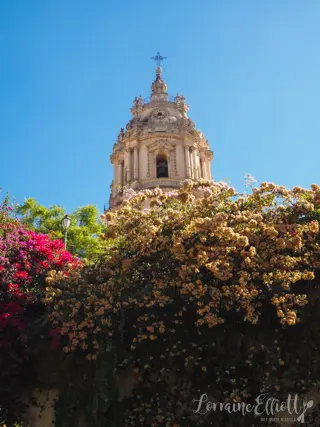
For the best views of Modica head up straight up the exactly 250 steps to The Cathedral of Chiesa di San Giorgio. It's a climb well worth making as the views are spectacular and endless. Entry to the cathedral is free and for an extra €2 you can climb the bell tower or just enjoy the view of the city below from the church. Its elevated level means that it is quieter and you don't get the hustle and bustle of the car lined streets below.
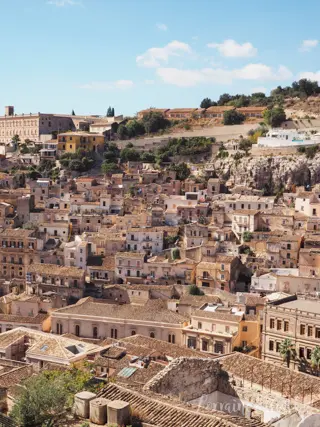
The other half of the group takes the train ride but if you want to get photos I would not recommend the 45 minute train ride because the train does not slow down to let you take photos.

After this we head for a lunch of cheese at Azienda Bussello. This dairy farm is located 600 metres above sea level and is surrounded by 12 towns. 58 year old Marcello Cannata owns Azienda Bussello and he gives us a history of how the dairy business was started, translated by Carm. When he and his wife were wed, he received 10 cows and a tractor from his father. This follows a tradition where his grandfather gave his father 2 cows and a horse. At the farm today he has Holstein Friesian cows but previously he had Modicana cows.
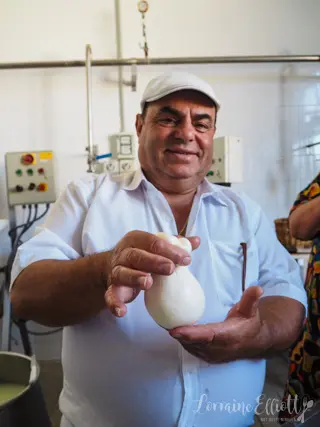
By 2008 he was selling his milk and cheese to 130 stores with his 10-50 cows. He was also purchasing milk from nearby farms. When milk prices were low he would make cheese and when milk prices were high he would sell milk. Then supermarkets started to reduce the margins paid to farmers. Marcello likes a challenge so he banded together with nearby olive, meat and cheese farmers and they created the first farmers market in Modica.
All 20 producers made just €10 on that first day.

Undeterred, they were permitted to move the market to a better location and customers flocked to the market for his hot ricotta. People would arrive with buckets and pay for their ricotta and return two hours later for their bucket of hot ricotta. The ricotta would be eaten, unadorned with oil or herbs with bread for a simple, inexpensive breakfast.
Marcello now focuses on markets and no longer supplies to the supermarkets. He preferred to make money on the spot rather than waiting for 30, 60 or 90 days to be paid by the supermarkets. He now has two 7 metre/23 foot food truck that sells 100 items from cheeses as well as his own fresh pork sausages as well as products from the bakery that he owns like biscuits, breads, scacce and focaccia.
And he also now makes €10 a minute at markets.

We head to the cheese factory where they are busy making cheese. They add rennet to curdle the milk to make mozzarella and with the leftover whey they make ricotta. Remember those olive pellets from yesterday? He uses them to heat the whey to make ricotta. He heats the milk up to 36C/96F and after 1 hour he cuts the milk and drains the whey from which he will make ricotta. The cheese in the bottom of the barrel will be made into caciocavallo cheese. This Sicilian caciocavallo cheese is given its name as it is shaped into teardrops or bricks and hung on a string in pairs resembling a horse saddle. The name translates into "cheese horse".
We get to shape some cheese and try the cheese at an early stage before they are salted and matured. Caciocavallo is now called Ragusana DOP and Marcello sells cheese aged up to 100 months or 9 years.
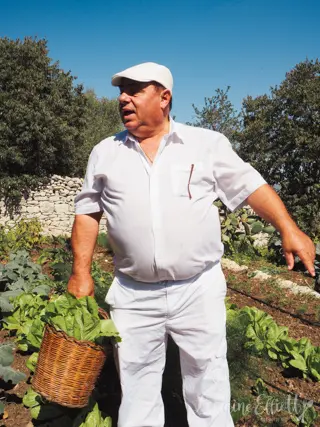
We follow him out to the garden where we pick fresh lettuces for lunch and follow him back inside to where a table is set up with a feast of food. There's provolone, some young cheese, 100 month cheese, salami, scacce, olives and caponata as well as bread from his bakery. This is followed by plates of cavatelli pasta with sugo or tomato based sauce and chunks of pork meat from his pigs and wine. Every 15 minutes or so Marcello raises his glass for a "Salute!".
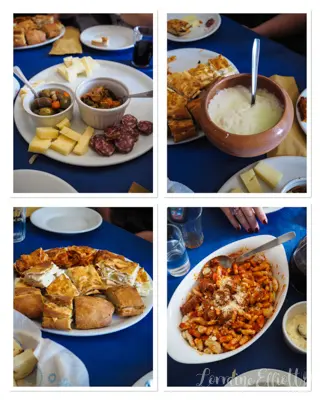
Also on the table there's large terracotta pots of the hot ricotta. We spoon some of it onto the bread and take a bite. The hot ricotta is incredible. It has the exact texture of Japanese chawanmushi with a milky flavour. It's remarkable and not grainy in the slightest, just giving a luscious creamy mouthful every single time.
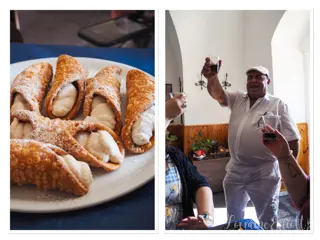
That afternoon we have a four hour break as people get ready to pack their bags and say goodbye to Scoglitti and food tour. We are all headed in different directions and Mr NQN and I are off to do a road trip of Sicily of areas like Taormina and Palermo as well as the small but beautiful town of Marzamemi. We meet for one last time for cocktails and dinner at Dolcidea in the centre of Scoglitti. This cafe and restaurant is what Carm calls "homebase" as it is owned by her cousins and is where you can go for breakfast or coffee if you want something outside of the hotel.
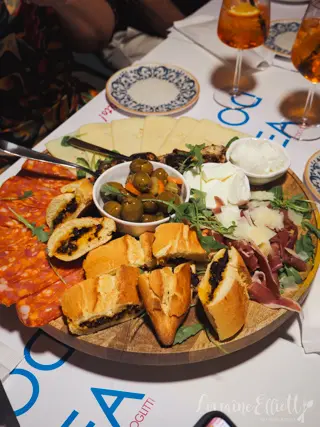
Dinner tonight starts with an antipasti platter made up of pani cunzatu (sun dried tomato sandwiches), prosciutto, salami, olives, grilled eggplant, cheeses and rocket salad. I wedge some prosciutto and salad in the pani cunzato and enjoy each mouthful.
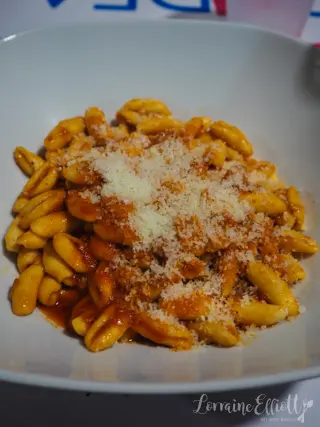
Then Carm has organised for a cavatelli with sugo sauce for our pasta main which is absolutely delicious. This comes out with a big platter of meatballs and pork ribs in sugo. The ribs fall off the bone while the meatballs are full of flavour.
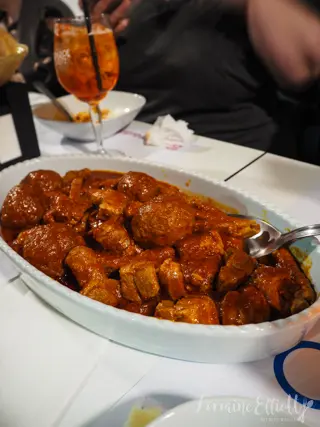
And for dessert, they've made us a special pistachio cake to celebrate the end of the Sicilian food tour. We enjoy slices of this cake with cocktails. It's a fitting sweet ending to this fantastic food tour of Sicily.
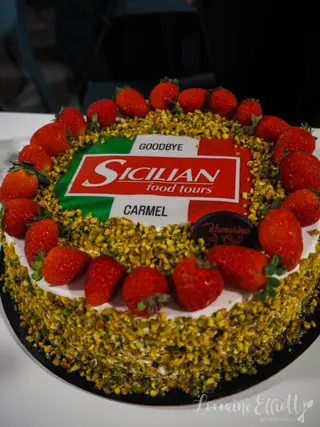
So tell me Dear Reader, have you ever tried Modica chocolate? And have you ever had hot, fresh ricotta cheese?
Want More Sicily? Here is the entire Sicily series:
- Taormina: The Pearl of the Ionian
- Scenic Sicily: Seaside Town Of Marzamemi
- Magical Modica, Sicily
- Sicilian Wineries, Olive Oil and A Family Dinner
- Ortigia and Noto: A Sicilian Love Affair
- Feasting On Vittoria and Ragusa Ibla, Sicily
- Seaside Charms of Scoglitti, Sicily
- Captivating Catania, Sicily
NQN and Mr NQN travelled to Europe as guests of Vietnam Airlines and NQN was a guest of Sicilian Food Tours but all opinions remain her own.
Sicilian Food Tours
To book the Sicilian Food Tour follow this link. If you use the code NQN when booking (please write it in the date field) then you'll get a bottle of Cerasuolo Wine from Vittoria, the only DOCG wine of Sicily. This cherry red wine variety is a blend of Sicily's famous Nero D'Avola & Frappato worth $80AUD.
Vietnam Airlines
Vietnam Airlines offers 23 flights per week connecting Sydney, Melbourne and Perth to Ho Chi Minh City and Hanoi. Vietnam Airlines is continuing to add new routes having recently announced new flights to Milan, Munich and Delhi.
https://www.vietnamairlines.com/au/en/home


Reader Comments
Loading comments...Add Comment